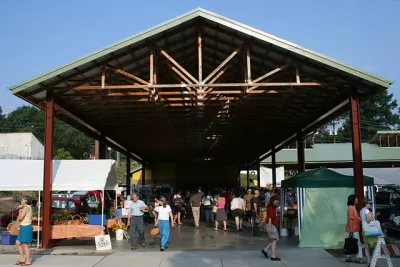New research shows that some U.S. communities are much better than others at attracting grants and financing for community development—even after adjusting for relative need. The numbers are clear, but the reasons for the disparity may not be.

You might think that community development funding in the United States—investments like small-business loans, federal housing grants, tax credits, and investments from community development financial institutions—go to local communities in rough proportion to their need. For example, in any given year, you’d expect communities to receive roughly the same amount of per-family and per-employee lending. And if any communities were prioritized, you’d hope they would be those that have higher levels of poverty and unemployment, as the public sector works to jump-start struggling economies.
As it turns out, that’s not the case. Urban Institute, through a grant from JPMorgan Chase, measured flows of federally sponsored or incentivized community development capital to all U.S. counties with more than 50,000 residents (which accounts for 88 percent of the U.S. population) using data from 2011 to 2015. We tracked funding in four dimensions: housing, small business, impact finance (loans from community development financial institutions and New Markets Tax Credit investments), and other community development programs. The upshot: some communities in the United States seem much better than others at attracting grants and financing for community development—even after adjusting for their relative needs. Here are some of the surprising trends we found:
Large counties get disproportionately more investment than small ones. You would expect that large counties with 300,000 or more residents get a lot more funding than small counties with less than 100,000 residents. But you’d also expect to see that difference go away once you adjust for the difference in size.
FULL STORY: How Successful is Your County in Accessing Community Development Funding?

Maui's Vacation Rental Debate Turns Ugly
Verbal attacks, misinformation campaigns and fistfights plague a high-stakes debate to convert thousands of vacation rentals into long-term housing.

Planetizen Federal Action Tracker
A weekly monitor of how Trump’s orders and actions are impacting planners and planning in America.

In Urban Planning, AI Prompting Could be the New Design Thinking
Creativity has long been key to great urban design. What if we see AI as our new creative partner?

King County Supportive Housing Program Offers Hope for Unhoused Residents
The county is taking a ‘Housing First’ approach that prioritizes getting people into housing, then offering wraparound supportive services.

Researchers Use AI to Get Clearer Picture of US Housing
Analysts are using artificial intelligence to supercharge their research by allowing them to comb through data faster. Though these AI tools can be error prone, they save time and housing researchers are optimistic about the future.

Making Shared Micromobility More Inclusive
Cities and shared mobility system operators can do more to include people with disabilities in planning and operations, per a new report.
Urban Design for Planners 1: Software Tools
This six-course series explores essential urban design concepts using open source software and equips planners with the tools they need to participate fully in the urban design process.
Planning for Universal Design
Learn the tools for implementing Universal Design in planning regulations.
planning NEXT
Appalachian Highlands Housing Partners
Mpact (founded as Rail~Volution)
City of Camden Redevelopment Agency
City of Astoria
City of Portland
City of Laramie





























